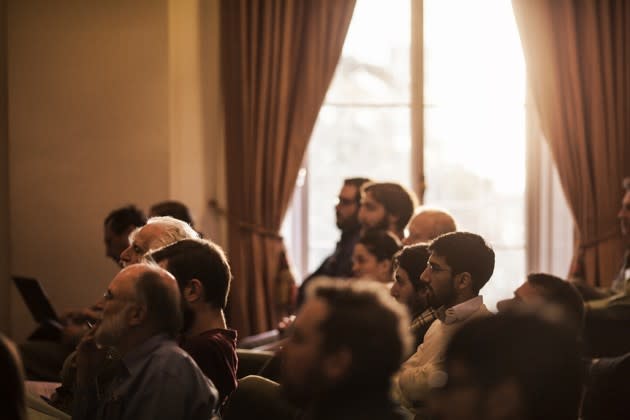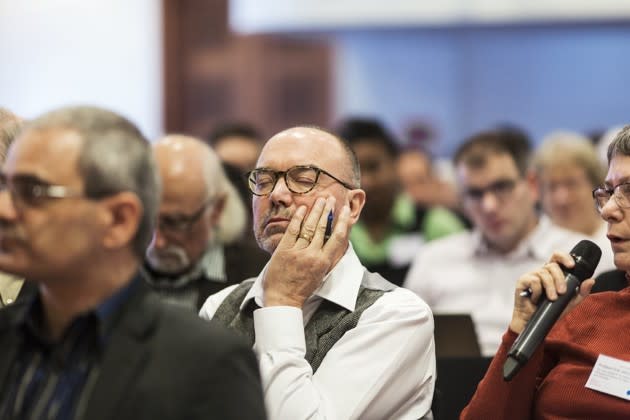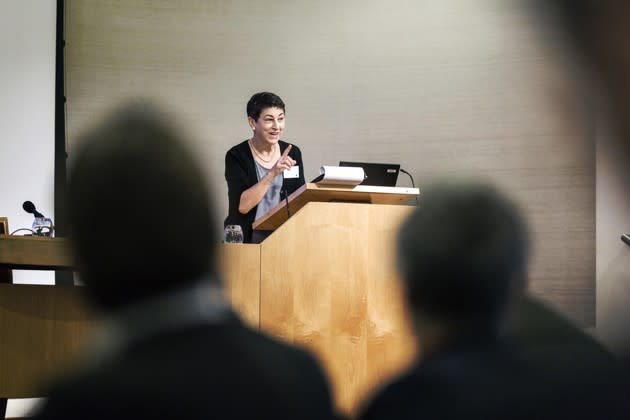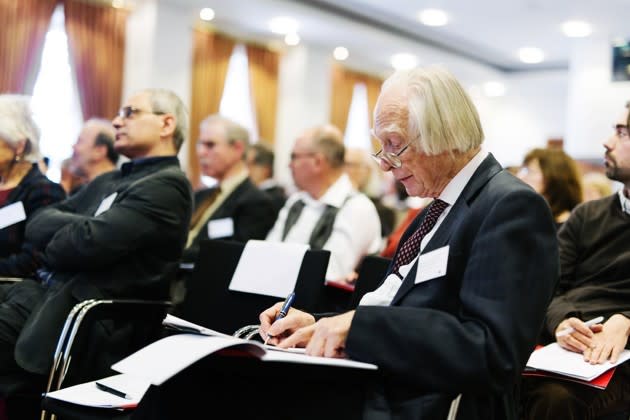The Biologists Who Want to Overhaul Evolution
Kevin Laland looked out across the meeting room at a couple hundred people gathered for a conference on the future of evolutionary biology. A colleague sidled up next to him and asked how he thought things were going.
More From Our Partners
“I think it’s going quite well,” Laland said. “It hasn’t gone to fisticuffs yet.”
Laland is an evolutionary biologist who works at the University of St. Andrews in Scotland. On a chilly gray November day, he came down to London to co-host a meeting at the Royal Society called “New Trends in Evolutionary Biology.” A motley crew of biologists, anthropologists, doctors, computer scientists, and self-appointed visionaries packed the room. The Royal Society is housed in a stately building overlooking St. James’s Park. Today the only thing for Laland to see out of the tall meeting-room windows was scaffolding and gauzy tarps set up for renovation work. Inside, Laland hoped, another kind of renovation would be taking place.
Recommended: The Case Against Reality
In the mid-1900s, biologists updated Darwin’s theory of evolution with new insights from genetics and other fields. The result is often called the Modern Synthesis, and it has guided evolutionary biology for over 50 years. But in that time, scientists have learned a tremendous amount about how life works. They can sequence entire genomes. They can watch genes turn on and off in developing embryos. They can observe how animals and plants respond to changes in the environment.

(Tom Parker / Quanta Magazine)
As a result, Laland and a like-minded group of biologists argue that the Modern Synthesis needs an overhaul. It has to be recast as a new vision of evolution, which they’ve dubbed the Extended Evolutionary Synthesis. Other biologists have pushed back hard, saying there is little evidence that such a paradigm shift is warranted.
This meeting at the Royal Society was the first public conference where Laland and his colleagues could present their vision. But Laland had no interest in merely preaching to the converted, and so he and his fellow organizers also invited prominent evolutionary biologists who are skeptical about the Extended Evolutionary Synthesis.
Recommended: The Understudied Female Sexual Predator
Both sides offered their arguments and critiques in a civil way, but sometimes you could sense the tension in the room—the punctuations of tsk-tsks, eye-rolling, and partisan bursts of applause.
But no fisticuffs. At least not yet.
* * *
Every science passes through times of revolution and of business as usual. After Galileo and Newton dragged physics out of its ancient errors in the 1600s, it rolled forward from one modest advance to the next until the early 1900s. Then Einstein and other scientists established quantum physics, relativity and other new ways of understanding the universe. None of them claimed that Newton was wrong. But it turns out there’s much more to the universe than matter in motion.
Evolutionary biology has had revolutions of its own. The first, of course, was launched by Charles Darwin in 1859 with his book On the Origin of Species.Darwin wove together evidence from paleontology, embryology and other sciences to show that living things were related to one another by common descent. He also introduced a mechanism to drive that long-term change: natural selection. Each generation of a species was full of variations. Some variations helped organisms survive and reproduce, and those were passed down, thanks to heredity, to the next generation.
Darwin inspired biologists all over the world to study animals and plants in a new way, interpreting their biology as adaptations produced over many generations. But he succeeded in this despite having no idea what a gene was. It wasn’t until the 1930s that geneticists and evolutionary biologists came together and recast evolutionary theory. Heredity became the transmission of genes from generation to generation. Variations were due to mutations, which could be shuffled into new combinations. New species arose when populations built up mutations that made interbreeding impossible.
Recommended: Trump's Two-Step on Climate Change
In 1942, the British biologist Julian Huxley described this emerging framework in a book called Evolution: The Modern Synthesis. Today, scientists still call it by that name. (Sometimes they refer to it instead as neo-Darwinism, although that’s actually a confusing misnomer. The term “neo-Darwinism” was actually coined in the late 1800s, to refer to biologists who were advancing Darwin’s ideas in Darwin’s own lifetime.)
The Modern Synthesis proved to be a powerful tool for asking questions about nature. Scientists used it to make a vast range of discoveries about the history of life, such as why some people are prone to genetic disorders like sickle-cell anemia and why pesticides sooner or later fail to keep farm pests in check. But starting not long after the formation of the Modern Synthesis, various biologists would complain from time to time that it was too rigid. It wasn’t until the past few years, however, that Laland and other researchers got organized and made a concerted effort to formulate an extended synthesis that might take its place.
The researchers don’t argue that the Modern Synthesis is wrong—just that it doesn’t capture the full richness of evolution. Organisms inherit more than just genes, for example: They can inherit other cellular molecules, as well as behaviors they learn and the environments altered by their ancestors. Laland and his colleagues also challenge the pre-eminent place that natural selection gets in explanations for how life got to be the way it is. Other processes can influence the course of evolution, too, from the rules of development to the environments in which organisms have to live.
“It’s not simply bolting more mechanisms on what we already have,” said Laland. “It requires you to think of causation in a different way.”
* * *
Eva Jablonka, a biologist at Tel Aviv University, used her talk to explore the evidence for a form of heredity beyond genes.
Our cells use a number of special molecules to control which of their genes make proteins. In a process called methylation, for example, cells put caps on their DNA to keep certain genes shut down. When cells divide, they can reproduce the same caps and other controls on the new DNA. Certain signals from the environment can cause cells to change these so-called “epigenetic” controls, allowing organisms to adjust their behavior to new challenges.

(Tom Parker / Quanta Magazine)
Some studies indicate that—under certain circumstances—an epigenetic change in a parent may get passed down to its offspring. And those children may pass down this altered epigenetic profile to their children. This would be kind of heredity that’s beyond genes.
The evidence for this effect is strongest in plants. In one study, researchers were able to trace down altered methylation patterns for 31 generations in a plant called Arabidopsis. And this sort of inheritance can make a meaningful difference in how an organism works. In another study, researchers found that inherited methylation patterns could change the flowering time of Arabidopsis, as well as the size of its roots. The variation that these patterns created was even bigger than what ordinary mutations caused.
After presenting evidence like this, Jablonka argued that epigenetic differences could determine which organisms survived long enough to reproduce. “Natural selection could work on this system,” she said.
While natural selection is an important force in evolution, the speakers at the meeting presented evidence for how it could be constrained, or biased in a particular direction. Gerd Müller, a University of Vienna biologist, offered an example from his own research on lizards. A number of species of lizards have evolved feet that have lost some toes. Some have only four toes, while others have just one, and some have lost their feet altogether.
The Modern Synthesis, Müller argued, leads scientists to look at these arrangements as simply the product of natural selection, which favors one variant over others because it has a survival advantage. But that approach doesn’t work if you ask what the advantage was for a particular species to lose the first toe and last toe in its foot, instead of some other pair of toes.
“The answer is, there is no real selective advantage,” said Müller.
The key to understanding why lizards lose particular toes is found in the way that lizard embryos develop toes in the first place. A bud sprouts off the side of the body, and then five digits emerge. But the toes always appear in the same sequence. And when lizards lose their toes through evolution, they lose them in the reverse order. Müller suspects this constraint is because mutations can’t create every possible variation. Some combinations of toes are thus off-limits, and natural selection can never select them in the first place.
Development may constrain evolution. On the other hand, it also provides animals and plants with remarkable flexibility. Sonia Sultan, an evolutionary ecologist from Wesleyan University, offered a spectacular case in point during her talk, describing a plant she studies in the genus Polygonum that takes the common name “smartweed.”
The Modern Synthesis, Sultan said, would lead you to look at the adaptations in a smartweed plant as the fine-tuned product of natural selection. If plants grow in low sunlight, then natural selection will favor plants with genetic variants that let them thrive in that environment—for example, by growing broader leaves to catch more photons. Plants that grow in bright sunlight, on the other hand, will evolve adaptations that let them thrive in those different conditions.
“It’s a commitment to that view that we’re here to confront,” Sultan said.
If you raise genetically identical smartweed plants under different conditions, Sultan showed, you’ll end up with plants that may look like they belong to different species.
For one thing, smartweed plants adjust the size of their leaves to the amount of sunlight they get. In bright light, the plants grow narrow, thick leaves, but in low light, the leaves become broad and thin. In dry soil, the plants send roots down deep in search of water, while in flood soil, they grow shallow hair-like roots that that stay near the surface.
Scientists at the meeting argued that this flexibility—known as plasticity—can itself help drive evolution. It allows plants to spread into a range of habitats, for example, where natural selection can then adapt their genes. And in another talk, Susan Antón, a paleoanthropologist at New York University, said that plasticity may play a significant role in human evolution that’s gone underappreciated till now. That’s because the Modern Synthesis has strongly influenced the study of human evolution for the past half century.
Paleoanthropologists tended to treat differences in fossils as the result of genetic differences. That allowed them to draw an evolutionary tree of humans and their extinct relatives. This approach has a lot to show for it, Antón acknowledged. By the 1980s, scientists had figured out that our early ancient relatives were short and small-brained up to about two million years ago. Then one lineage got tall and evolved big brains. That transition marked the origin of our genus, Homo.
But sometimes paleoanthropologists would find variations that were harder to make sense of. Two fossils might look in some ways like they should be in the same species but look too different in other respects. Scientists would usually dismiss those variations as being caused by the environment. “We wanted to get rid of all that stuff and get down to their essence,” Antón said.
But that stuff is now too abundant to ignore. Scientists have found a dizzying variety of humanlike fossils dating back to 1.5 to 2.5 million years ago. Some are tall, and some are short. Some have big brains and some have small ones. They all have some features of Homo in their skeleton, but each has a confusing mix-and-match assortment.

(Tom Parker / Quanta)
Antón thinks that the Extended Evolutionary Synthesis can help scientists make sense of this profound mystery. In particular, she thinks that her colleagues should take plasticity seriously as an explanation for the weird diversity of early Homo fossils.
To support this idea, Antón pointed out that living humans have their own kinds of plasticity. The quality of food a woman gets while she’s pregnant can influence the size and health of her baby, and those influences can last until adulthood. What’s more, the size of a woman—influenced in part by her own mother’s diet—can influence her own children. Biologists have found that women with longer legs tend to have larger children, for example.
Antón proposed that the weird variations in the fossil record might be even more dramatic examples of plasticity. All these fossils date to when Africa’s climate fell into a period of wild climate swings. Droughts and abundant rains would have changed the food supply in different parts of the world, perhaps causing early Homo to develop differently.
The Extended Evolutionary Synthesis may also help make sense of another chapter in our history: the dawn of agriculture. In Asia, Africa and the Americas, people domesticated crops and livestock. Melinda Zeder, an archaeologist at the Smithsonian Institution, gave a talk at the meeting about the long struggle to understand how this transformation unfolded.
Before people farmed, they foraged for food and hunted wild game. Zeder explained how many scientists treat the behavior of the foragers in a very Modern Synthesis way: as finely tuned by natural selection to deliver the biggest payoff for their effort to find food.
The trouble is that it’s hard to see how such a forager would ever switch to farming. “You don’t get the immediate gratification of grabbing some food and putting it in your mouth,” Zeder told me.
Some researchers suggested that the switch to agriculture might have occurred during a climate shift, when it got harder to find wild plants. But Zeder and other researchers have actually found no evidence of such a crisis when agriculture arose.
Zeder argues that there’s a better way of thinking about this transition. Humans are not passive zombies trying to survive in a fixed environment. They are creative thinkers who can change the environment itself. And in the process, they can steer evolution in a new direction.
Scientists call this process niche construction, and many species do it. The classic case is a beaver. It cuts down trees and makes a dam, creating a pond. In this new environment, some species of plants and animals will do better than others. And they will adapt to their environment in new ways. That’s true not just for the plants and animals that live around a beaver pond, but for the beaver itself.
When Zeder first learned about niche construction, she says, it was a revelation. “Little explosions were going off in my head,” she told me. The archaeological evidence she and others had gathered made sense as a record of how humans changed their own environment.
Early foragers show signs of having moved wild plants away from their native habitats to have them close at hand, for example. As they watered the plants and protected them from herbivores, the plants adapted to their new environment. Weedy species also moved in and became crops of their own. Certain animals adapted to the environment as well, becoming dogs, cats and other domesticated species.
Gradually, the environment changed from sparse patches of wild plants to dense farm fields. That environment didn’t just drive the evolution of the plants. It also began to drive the cultural evolution of the farmers, too. Instead of wandering as nomads, they settled down in villages so that they could work the land around them. Society became more stable because children received an ecological inheritance from their parents. And so civilization began.
Niche construction is just one of many concepts from the Extended Evolutionary Synthesis that can help make sense of domestication, Zeder said. During her talk, she presented slide after slide of predictions it provides, about everything from the movements of early foragers to the pace of plant evolution.
“It felt like an infomercial for the Extended Evolutionary Synthesis,” Zeder told me later with a laugh. “But wait! You can get steak knives!”
* * *
Among the members of the audience was a biologist named David Shuker. After listening quietly for a day and a half, the University of St Andrews researcher had had enough. At the end of a talk, he shot up his hand.
The talk had been given by Denis Noble, a physiologist with a mop of white hair and a blue blazer. Noble, who has spent most of his career at Oxford, said he started out as a traditional biologist, seeing genes as the ultimate cause of everything in the body. But in recent years he had switched his thinking. He spoke of the genome not as a blueprint for life but as a sensitive organ, detecting stress and rearranging itself to cope with challenges. “I’ve been on a long journey to this view,” Noble said.
To illustrate this new view, Noble discussed an assortment of recent experiments. One of them was published last year by a team at the University of Reading. They did an experiment on bacteria that swim by spinning their long tails.
First, the scientists cut a gene out of the bacteria’s DNA that’s essential for building tails. The researchers then dropped these tailless bacteria into a petri dish with a meager supply of food. Before long, the bacteria ate all the food in their immediate surroundings. If they couldn’t move, they died. In less than four days in these dire conditions, the bacteria were swimming again. On close inspection, the team found they were growing new tails.

(Tom Parker / Quanta Magazine)
“This strategy is to produce rapid evolutionary genome change in response to the unfavorable environment,” Noble declared to the audience. “It’s a self-maintaining system that enables a particular characteristic to occur independent of the DNA.”
That didn’t sound right to Shuker, and he was determined to challenge Noble after the applause died down.
“Could you comment at all on the mechanism underlying that discovery?” Shuker asked.
Noble stammered in reply. “The mechanism in general terms, I can, yes…” he said, and then started talking about networks and regulation and a desperate search for a solution to a crisis. “You’d have to go back to the original paper,” he then said.
While Noble was struggling to respond, Shuker went back to the paper on an iPad. And now he read the abstract in a booming voice.
“‘Our results demonstrate that natural selection can rapidly rewire regulatory networks,’” Shuker said. He put down the iPad. “So it’s a perfect, beautiful example of rapid neo-Darwinian evolution,” he declared.
Shuker distilled the feelings of a lot of skeptics I talked to at the conference. The high-flying rhetoric about a paradigm shift was, for the most part, unwarranted, they said. Nor were these skeptics limited to the peanut gallery. Several of them gave talks of their own.
“I think I’m expected to represent the Jurassic view of evolution,” saidDouglas Futuyma when he got up to the podium. Futuyma is a soft-spoken biologist at Stony Brook University in New York and the author of a leading textbook on evolution. In other words, he was the target of many complaints during the meeting that textbooks paid little heed to things like epigenetics and plasticity. In effect, Futuyma had been invited to tell his colleagues why those concepts were ignored.
“We must recognize that the core principles of the Modern Synthesis are strong and well-supported,” Futuyma declared. Not only that, he added, but the kinds of biology being discussed at the Royal Society weren’t actually all that new. The architects of the Modern Synthesis were already talking about them over 50 years ago. And there’s been a lot of research guided by the Modern Synthesis to make sense of them.
Take plasticity. The genetic variations in an animal or a plant govern the range of forms into which organism can develop. Mutations can alter that range. And mathematical models of natural selection show how it can favor some kinds of plasticity over others.
If the Extended Evolutionary Synthesis was so superfluous, then why was it gaining enough attention to warrant a meeting at the Royal Society? Futuyma suggested that its appeal was emotional rather than scientific. It made life an active force rather than the passive vehicle of mutations.
“I think what we find emotionally or aesthetically more appealing is not the basis for science,” Futuyma said.
Still, he went out of his way to say that the kind of research described at the meeting could lead to some interesting insights about evolution. But those insights would only arise with some hard work that leads to hard data. “There have been enough essays and position papers,” he said.
Some members in the audience harangued Futuyma a bit. Other skeptical speakers sometimes got exasperated by arguments they felt didn’t make sense. But the meeting managed to reach its end on the third afternoon without fisticuffs.
“This is likely the first of many, many meetings,” Laland told me. In September, a consortium of scientists in Europe and the United States received $11 million in funding (including $8 million from the John Templeton Foundation) to run 22 studies on the Extended Evolutionary Synthesis.
Many of these studies will test predictions that have emerged from the synthesis in recent years. They will see, for example, if species that build their own environments—spider webs, wasp nests and so on—evolve into more species than ones that don’t. They will look at whether more plasticity allows species to adapt faster to new environments.
“It’s doing the research, which is what our critics are telling us to do,” said Laland. “Go find the evidence.”
This article appears courtesy of Quanta Magazine.
Read more from The Atlantic:
This article was originally published on The Atlantic.


